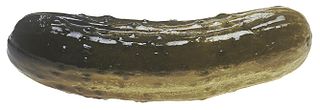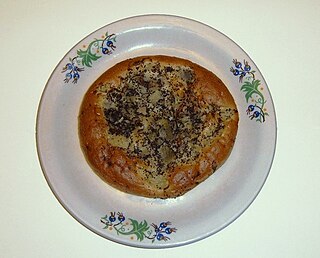In cookbooks
Mikołaj Rej in Żywot człowieka poczciwego wrote about drying and salting mushrooms as methods of preserving them, but did not mention marinating in vinegar, even though in the same paragraph he described the preparation of pickled beets and fennel. [33]
In the first Polish cookbook, Compendium ferculorum, albo Zebranie potraw from 1682, authored by Stanisław Czerniecki, the master chef of the Kraków duke, Aleksander Michał Lubomirski, various types of mushrooms essential for household needs were listed, including fresh mushrooms, dried mushrooms, fresh delicious milk cap, salted delicious milk cap, fresh agaricus , and agaricus in butter, but no mention was made of any kind of marinated mushrooms. [34]
In Jakub Kazimierz Haur's book Oekonomika ziemiańska generalna from 1675 (later editions in 1744), there is no information about marinating mushrooms, although the author advises salting and smoking mushrooms in August. [35]
During this time, in 1695, in France, the French Academy published a dictionary Le dictionnaire de l'Académie françoise, dédié au Roy, which as an illustration of the word mariné (marinate) provided the phrase des champignons marinez (marinated mushrooms). [36] In England, marinated mushrooms were mentioned in the rural dictionary Dictionarium Rusticum & Urbanicum. Or, A Dictionary of All Sorts of Country Affairs, Handicraft, Trading, and Merchandizing by John Worlidge and Nathan Bailey, published in 1704. [37]
In the first half of the 18th century, numerous English cookbooks contained recipes for marinating mushrooms, sometimes even several different ones. Marinating mushrooms was discussed in household manuals for both women, such as The Whole Duty of a Woman, Or, An Infallible Guide to the Fair Sex from 1737, [38] and for men, such as The Complete family-piece; and, country gentleman, and farmer's, best guide, also published in 1737. [39] From the latter, there is a specific recipe for cooking mushrooms in milk and using nutmeg and mace as spices. The recipe from the book for women is identical word for word. [38] [39]
In Johann Gottlieb Gleditsch's book on mushrooms Methodus fungorum, published in Berlin in 1753, marinated mushrooms were mentioned. [40] Likewise, in the contemporary French culinary dictionary Dictionnaire des alimens, vins et liqueurs, leurs qualité, leurs effets etc. from 1750, there was a recipe for marinating mushrooms. [41] In German, a recipe for marinated mushrooms appeared in Johann Georg Krünitz's Oekonomische Encyklopädie in 1776. [42]
The English book The Accomplished Housekeeper, and Universal Cook by T. Williams, published in 1797, contained numerous examples of using marinated mushrooms in the kitchen. They were used as a flavor enhancer for meat, fish, poultry dishes, and even eggs. [31]
During the same period in Poland, in the translated and adapted French book Kucharz doskonały by Wojciech Wielądko from 1783, there was no recipe for marinating mushrooms or any mention of them. [43] Recipes for marinated mushrooms in vinegar appeared in a Polish cookbook from the late 18th century: the anonymous book Gospodarz doskonały, first published in Dresden in 1790, contained a recipe for marinated delicious milk caps. [44]
In Russia, in 1792, a book titled "Новый совершенный российский повар и кандитер, или, Подробный поваренский и кандитерский словарь" was printed, containing a recipe for marinating mushrooms with the addition of pepper, ginger root, and cloves as spices. [45] The recipe also included a brochure translated from German "О грибах, употребляемых в пищу" from 1834, which proposed pepper, bay leaves, mustard, and cloves as spices for marinating mushrooms. [46] Marinating forest mushrooms, specifically ceps, was also suggested in the German work Neues auf Erfahrung gegründetes leichtfaßliches Kochbuch für jede Haushaltung by M. A. Salzmann from 1835. [47]
In Poland, in the 19th century, an anonymous Polish publication Kucharka wiedeńska provided a recipe for preserving mushrooms. [32]
Marinated mushrooms also appeared in the cookbook by Lucyna Ćwierczakiewiczowa from 1893, [48] where the author provided a method for marinating them. She also pointed out an alternative method for marinating mushrooms, which she believed was commonly used by chefs: rinsed mushrooms should be placed in boiling, heavily salted water, and after boiling, drained and poured into jars with cold vinegar with a small amount of spices. [48]
This dish was also mentioned in the Soviet encyclopedia "Краткая энциклопедия домашнего хозяйства" (Moscow, 1960) [2] and in the commodity dictionary "Товарный словарь" (vol. III, Moscow, 1957). [49]

















